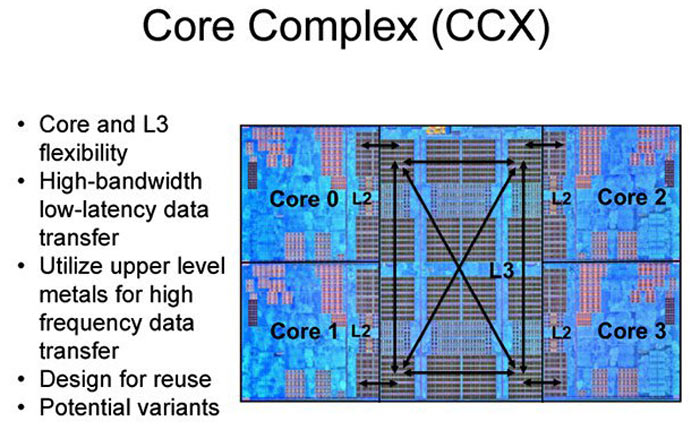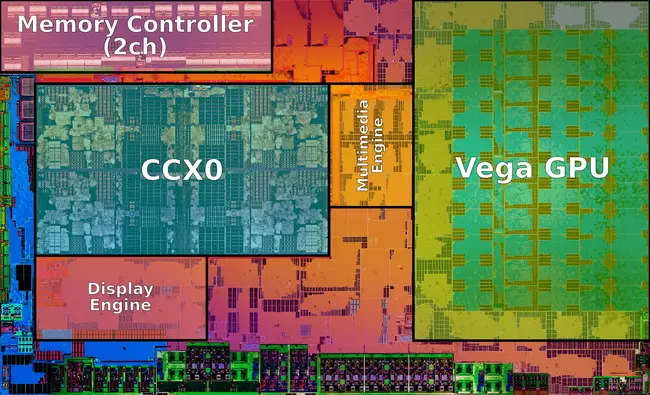First let me preface this by saying I am no expert, nor do I have any unique information or even really know what I'm talking about. The following was written solely based on observed trends in hardware fabrication and specifically AMD.
One of the things people have been questioning is what exactly is going into the specs of a next gen console. I have given some guesses but I think I've finalized a theory based on AMD's fabrication process.
1) Chip manufacturing.
In case you having seen it AMD has a very efficient chip manufacturing process.
The basics of a Ryzen AMD processor look like such:
Here you can clearly see the four core nature of its chip.
The Ryzen 5 and above take the same chip and double it.
Even when in a 4 or 6 core configuration the extra silicon is produced and simply binned down and cores disabled.
The Threadripper and Epyc processors take this a step further.
revealing high-end AMD processors are nothing more than 4 Ryzen 5s on the same package, which in turn are for the most part doubled fabrications of its base processor.
The revealing thing about this is that it gives excellent economies of scale and shows AMD is not afraid to pack in the silicon even if its unused.
So how Does this relate to Next Gen consoles?
My theory is that whatever we give will be a scaled up existing product.
Thus, if we look at what AMD would produce as a base processor we could scale up with minimal design costs.
Now realistically to keep both cost and heat down the requirement would be to include an APU.
Currently we have mobile and desktop APUs which for all intents and purposes are the same chips.
These have been primarily built on the 14 and 12nm process.
The 2400G is the top of the line APU and produces 1.76 TFlops. Around the same as a base PS4.
A theoretically move to 7nm Vega or Navi and Zen2 could cut the die size in half or double the existing transistor performance.
My first thought was that AMD going to 7nm could mean a doubling of everything on their mobile and desktop APUs.
But then I thought about it.. A 4core 8thread APU will simply be enough for most users and get little use from 8c/16t.
So.. If I'm AMD why not just allocate the space savings to additional GPU compute units.
The current has 11 CUs active with a supposed 12 total for yield purposes.
At 7nm it would be feasible to put 36cus on a single die with 4c/8t cpu.
Further the 7nm process should allow us to run at higher mhz as well
So for testing purposes what would a 32cus at approximately 1400mhz look like for an APU in terms of Tflops?
Well to start its 2,048 Rops yielding approximately 5.7Tflops.... more than a PS4 Pro!!
But will that cut it for next gen... Absolutely not..
But AMD also no problem doubling their fabricated chip. So that does this mean?
Imagine a Ryzen 5 style APU 8c/16t 64cus single chip. Which is smaller than the current chip in the PS4.
Sound interesting?
I would like to think so..
But wait.. We know that AMD is committed to 2.5D and 3D chip stacking technology.
In theory it could also be financially feasible to have 4 single stack HBM2 or low cost HBM stacks for close to 1TB Bandwidth.
How is this financially feasible? Well Samsung produced the RAM in the PS4 and is ramping up both GDDR6 and HBM production.
So wait, Am I saying the PS5 will use HBM?
I'm saying the PS5 could theoretically use BOTH. A 4GB HBM stack direct on the APU for 1TB bandwidth and a 16GB stack of GDDR6 RAM for system memory.
This would also make sense in the claims of a "dedicated video card". The vcard isn't seperate, just the VRAM.
Ok, but what benefit does that have?
VR. Dual GPUs when actually configured using AMDs Liquid VR split the processing load and display.
having a dual APU with high bandwidth means increased framerate needed for VR. With GDDR6 still being fast enough to compensate for any overflow.
Sound cool, what else you got?
5G. Sony and MS have repeated stated their commitment to streaming services. While not important on initial launch I think that 5G will be come significant mid-gen.
Personal theory. A PS5 competitor to the Switch called PS5g. Through a die shrink I think a mid-gen PS5 could potentially follow in the footsteps of PSOne and PSP Go.
So in other words... a portable Mid-gen refresh of the PS5 sans media drive and digital only but with 5G capability.
This is not even taking into consideration what we may see with Super SIMD and Navi or whether Ray-tracing will take effect, but this leads me to one last conclusion.
The return of the cloud and cloud processing.
Last year Epic purchased a company called Cloudgine for intergration into Unreal Engine.
https://venturebeat.com/2018/01/22/...-devs-can-offload-game-processing-to-servers/
Here's more detail if you want, but I'm pretty ecstatic about what these new systems may have.[/quote]
One of the things people have been questioning is what exactly is going into the specs of a next gen console. I have given some guesses but I think I've finalized a theory based on AMD's fabrication process.
1) Chip manufacturing.
In case you having seen it AMD has a very efficient chip manufacturing process.
The basics of a Ryzen AMD processor look like such:
Here you can clearly see the four core nature of its chip.
The Ryzen 5 and above take the same chip and double it.
Even when in a 4 or 6 core configuration the extra silicon is produced and simply binned down and cores disabled.
The Threadripper and Epyc processors take this a step further.
revealing high-end AMD processors are nothing more than 4 Ryzen 5s on the same package, which in turn are for the most part doubled fabrications of its base processor.
The revealing thing about this is that it gives excellent economies of scale and shows AMD is not afraid to pack in the silicon even if its unused.
So how Does this relate to Next Gen consoles?
My theory is that whatever we give will be a scaled up existing product.
Thus, if we look at what AMD would produce as a base processor we could scale up with minimal design costs.
Now realistically to keep both cost and heat down the requirement would be to include an APU.
Currently we have mobile and desktop APUs which for all intents and purposes are the same chips.
These have been primarily built on the 14 and 12nm process.
The 2400G is the top of the line APU and produces 1.76 TFlops. Around the same as a base PS4.
A theoretically move to 7nm Vega or Navi and Zen2 could cut the die size in half or double the existing transistor performance.
As you can see from the die shot the GPU portion really only consumes about 1/3 of the total size while the CCX0 core is quite large.
My first thought was that AMD going to 7nm could mean a doubling of everything on their mobile and desktop APUs.
But then I thought about it.. A 4core 8thread APU will simply be enough for most users and get little use from 8c/16t.
So.. If I'm AMD why not just allocate the space savings to additional GPU compute units.
The current has 11 CUs active with a supposed 12 total for yield purposes.
At 7nm it would be feasible to put 36cus on a single die with 4c/8t cpu.
Further the 7nm process should allow us to run at higher mhz as well
So for testing purposes what would a 32cus at approximately 1400mhz look like for an APU in terms of Tflops?
Well to start its 2,048 Rops yielding approximately 5.7Tflops.... more than a PS4 Pro!!
But will that cut it for next gen... Absolutely not..
But AMD also no problem doubling their fabricated chip. So that does this mean?
Imagine a Ryzen 5 style APU 8c/16t 64cus single chip. Which is smaller than the current chip in the PS4.
Sound interesting?
I would like to think so..
But wait.. We know that AMD is committed to 2.5D and 3D chip stacking technology.
In theory it could also be financially feasible to have 4 single stack HBM2 or low cost HBM stacks for close to 1TB Bandwidth.
How is this financially feasible? Well Samsung produced the RAM in the PS4 and is ramping up both GDDR6 and HBM production.
So wait, Am I saying the PS5 will use HBM?
I'm saying the PS5 could theoretically use BOTH. A 4GB HBM stack direct on the APU for 1TB bandwidth and a 16GB stack of GDDR6 RAM for system memory.
This would also make sense in the claims of a "dedicated video card". The vcard isn't seperate, just the VRAM.
Ok, but what benefit does that have?
VR. Dual GPUs when actually configured using AMDs Liquid VR split the processing load and display.
having a dual APU with high bandwidth means increased framerate needed for VR. With GDDR6 still being fast enough to compensate for any overflow.
Sound cool, what else you got?
5G. Sony and MS have repeated stated their commitment to streaming services. While not important on initial launch I think that 5G will be come significant mid-gen.
Personal theory. A PS5 competitor to the Switch called PS5g. Through a die shrink I think a mid-gen PS5 could potentially follow in the footsteps of PSOne and PSP Go.
So in other words... a portable Mid-gen refresh of the PS5 sans media drive and digital only but with 5G capability.
This is not even taking into consideration what we may see with Super SIMD and Navi or whether Ray-tracing will take effect, but this leads me to one last conclusion.
The return of the cloud and cloud processing.
Last year Epic purchased a company called Cloudgine for intergration into Unreal Engine.
https://venturebeat.com/2018/01/22/...-devs-can-offload-game-processing-to-servers/
Here's more detail if you want, but I'm pretty ecstatic about what these new systems may have.[/quote]
Last edited:





